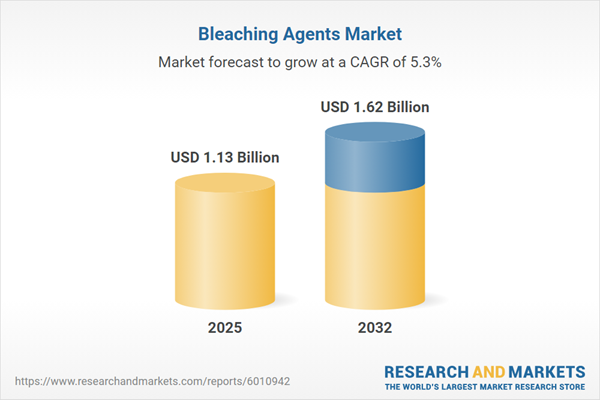Speak directly to the analyst to clarify any post sales queries you may have.
Senior executives navigating the bleaching agents market must take a proactive approach to risk, compliance, and innovation. Decision-makers are tasked with ensuring supply continuity, aligning with changing regulations, and capturing new value through advanced procurement and supplier management strategies.
Market Snapshot: Bleaching Agents Market Overview
The global bleaching agents market is demonstrating stable growth, propelled by persistent end-user demand across varied sectors. Standing at a valuation of USD 1.08 billion in 2024, the market is forecast to reach USD 1.13 billion by 2025, advancing at a compound annual growth rate (CAGR) of 5.26%. Projections estimate the industry will achieve a value of USD 1.62 billion by 2032.
Growth drivers include stricter sustainability measures, ongoing regulatory advancements, and product innovation. Market players are focused on diversifying solutions and responding to regional patterns in regulation and demand, ensuring continued relevance and reinforcing strategic positioning for the future.Scope & Segmentation: Bleaching Agents Market
To remain competitive, leaders must dissect the market’s evolving structure and segment-specific opportunities. Enhanced segmentation supports more informed sourcing and investment decisions while mitigating risks tied to regulation and sustainability. The current competitive landscape requires operational agility and supplier-risk management across a variety of market facets.
- Bleach Types: Chlorine-based, oxygen-based, and enzymatic agents offer differing compliance profiles and operational benefits tailored to sector-specific standards and workflows.
- Formulations: Granules, liquids, and powders deliver operational flexibility, allowing for adaptation in manufacturing, logistics, and storage solutions.
- End Use Applications: Key usage spans food processing, pulp and paper production, textiles, water treatment, institutional and residential cleaning, and a spectrum of industrial contexts where reliability and compliance influence procurement planning.
- Distribution Channels: Direct procurement, hypermarkets, supermarkets, online platforms, and specialty outlets equip organizations with diverse channels to maintain uninterrupted supply and responsive service.
- Geographies: The Americas, Europe, Middle East and Africa, and Asia-Pacific each display distinctive adoption patterns, infrastructure readiness, and supplier qualification standards—dictating necessary adjustments to sourcing and entry strategies.
- Leading Market Players: Organizations such as Nouryon Chemicals B.V., Solvay SA, Evonik Industries AG, Kemira Oyj, Dow Inc., BASF SE, Arkema S.A., Wacker Chemie AG, Mitsubishi Gas Chemical Company, Inc., and Daicel Corporation set the pace for innovation and regional adaptation in product offerings.
Key Takeaways for Senior Decision-Makers
- Growing preference for bio-based and enzyme-enhanced bleaching agents reflects industry alignment with increasing sustainability mandates and regulatory initiatives.
- Recent advancements in formulation science address operational efficiency and innovation, especially within highly regulated verticals such as textiles and food processing.
- Strong supplier relationship management, paired with adaptive logistics approaches, enhances flexibility as both trade environments and compliance requirements shift.
- Utilization of digital supply chain analytics streamlines procurement, improving quality management, transparency, and contract agility throughout global supply chains.
- Cross-sector collaboration among producers, technology partners, and research entities is essential for customizing solutions and addressing operational challenges as industry demands evolve.
Tariff Impact and Sourcing Strategies
Ongoing changes in U.S. import tariffs are introducing additional procurement complexities. To maintain reliable supply chains, organizations are expanding sourcing in alternative geographies and broadening their supplier networks. Investments in research and adaptive procurement strategies also support resilience in response to evolving international trade dynamics.
Methodology & Data Sources
This market assessment is grounded in qualitative interviews with industry executives and quantitative analysis from recognized industry datasets, regulatory disclosures, and validated market inputs. All findings are verified and cross-checked to maximize executive trust and utility for decision-making.
Why This Report Matters: Bleaching Agents Market Focus
- Empowers procurement and compliance teams to anticipate and adapt to changing regulatory and sustainability demands in the bleaching agents sector.
- Delivers actionable intelligence on emerging opportunities, differences in regional strategy, and the impact of technological developments.
- Prepares risk-conscious leadership to navigate a shifting operational landscape with practical, validated insights tied to immediate and future market challenges.
Conclusion
Sustained performance in the bleaching agents market hinges on precise procurement planning, continuous solution improvement, and rigorous compliance monitoring. Prioritizing these pillars enables organizations to adapt confidently as the industry evolves.
Additional Product Information:
- Purchase of this report includes 1 year online access with quarterly updates.
- This report can be updated on request. Please contact our Customer Experience team using the Ask a Question widget on our website.
Table of Contents
3. Executive Summary
4. Market Overview
7. Cumulative Impact of Artificial Intelligence 2025
Companies Mentioned
The companies profiled in this Bleaching Agents market report include:- Nouryon Chemicals B.V.
- Solvay SA
- Evonik Industries AG
- Kemira Oyj
- Dow Inc.
- BASF SE
- Arkema S.A.
- Wacker Chemie AG
- Mitsubishi Gas Chemical Company, Inc.
- Daicel Corporation
Table Information
| Report Attribute | Details |
|---|---|
| No. of Pages | 181 |
| Published | October 2025 |
| Forecast Period | 2025 - 2032 |
| Estimated Market Value ( USD | $ 1.13 Billion |
| Forecasted Market Value ( USD | $ 1.62 Billion |
| Compound Annual Growth Rate | 5.2% |
| Regions Covered | Global |
| No. of Companies Mentioned | 11 |









